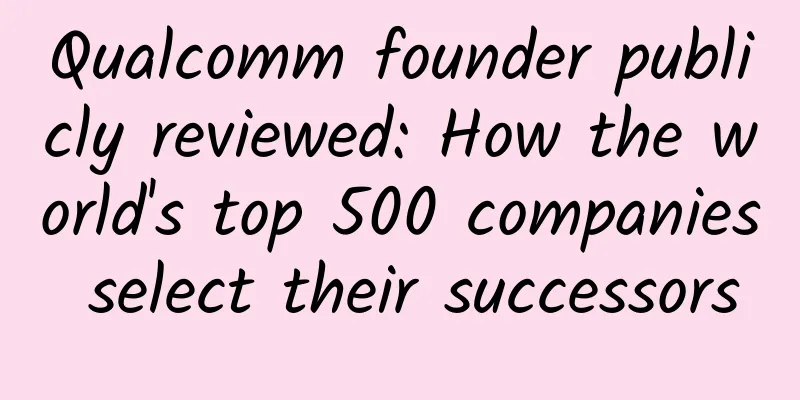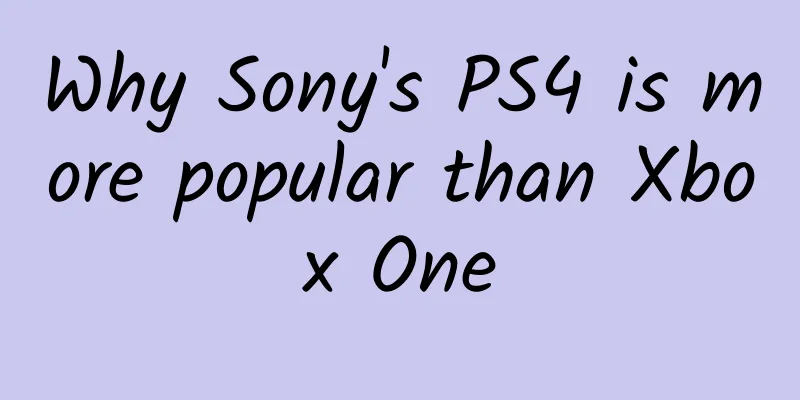Qualcomm founder publicly reviewed: How the world's top 500 companies select their successors

|
On December 12th, West Coast time, at Qualcomm headquarters in San Diego, we met Irwin Jacobs (hereinafter referred to as Irwin) whom we hadn’t seen for a long time. This is an old man who has been written into legend. At first, he studied hotel management in college, but after only one and a half years, he decisively switched to electrical engineering, and finally stayed on to teach at MIT after obtaining a doctorate degree. In 1968, he resigned from his 13-year teaching job and started a business with two partners, establishing a well-known technology consulting company Linkabit, and then worked there for 17 years until he retired at the age of 52. For many people, this is already a life that is admired, but for Ivan, his brilliant career has just begun. Less than three months after Linkabit retired, he co-founded Qualcomm with six partners and served as chairman and president. It was not until 2005 that he retired behind the scenes at the age of 72, handing over his work to his son Paul Jacobs (hereinafter referred to as Paul), and retired completely in 2012. Today, Qualcomm has grown into the world's largest wireless semiconductor supplier, an industry giant with more than 30,000 employees worldwide, more than 2 million mobile phone chips shipped every day, and providing technology licensing services to nearly 1,000 technology giants around the world. According to the financial report released in November this year, its revenue in fiscal year 2016 was US$23.6 billion, and its net profit exceeded US$5.7 billion. In recent years, Irwin has been living in seclusion and has not appeared in the media spotlight. This time, facing the Chinese media, he gave a complete review of Qualcomm's 30-year development history for the first time and revealed the detailed process of the handover between the first and second generations of Qualcomm. Fortunately, although he is already 83 years old, Irwin is still vigorous, healthy, clear-headed, and looks like a middle-aged man. Of course, I won’t tell you that he almost canceled his long-scheduled dentist appointment for this meeting with the Chinese media. 1. At the beginning of Qualcomm, Irwin proudly told his wife: Our company may soon grow to 100 people. Today, Qualcomm is 300 times bigger than he expected. (This reminds me of the JD.com startup video that was circulated before, where Liu Qiangdong made an annual plan in his year-end speech: Well, we must hire a warehouse manager next year!) 2. When CDMA was first promoted in 1989, most people had no expectations for Qualcomm's CDMA technology: some thought it was too expensive, some did not trust its quality, and some thought it took too long to develop. However, after Qualcomm insisted on doing demonstrations in San Diego and New York, customers finally changed their minds - at that time, it was a critical period to replace analog communications (1G) with digital communications (2G). Although the mainstream European TDMA technology could increase user capacity by 3 times compared to analog communications, CDMA's user capacity could increase by 10 to 20 times under the same spectrum. 3. The earliest demonstration of CDMA in China was in 1992. After that, Qualcomm spent nearly 10 years to promote the successful implementation of CDMA in mainland China, and finally China Unicom launched it for commercial use in 2001. At that time, many analysts were not optimistic about the Chinese market, but it turned out that China has grown into Qualcomm's most important overseas market. 4. Moore's Law will continue to work for some time. Of course, if we look at the overall situation, with the development of technology, the cost of transistors is not decreasing as fast as before. But in the development of sensor applications, VR/AR, big data, cloud computing, artificial intelligence, robotics and other technologies, mobile communications will also play an important role. In Irwin's words, "the next 10 years will be exciting." 5. Qualcomm made a difficult but correct decision in 1999 to abandon its mobile phone and system businesses and focus solely on chip technology research and development. At that time, the mobile phone business accounted for 60% of Qualcomm's revenue! Few companies dare to be so willing and take such risks, but looking back now, it was this decision that allowed Qualcomm's core technology to be quickly introduced to the market and eventually become the market leader. 6. Qualcomm's management philosophy is to encourage employees to innovate and communicate as much as possible, so that everyone's ideas can be fully discussed and studied. 7. In fact, as early as 2002, Irwin had already proposed his retirement to the board of directors. Afterwards, Qualcomm formed a special committee to find the next leader. A total of 10 candidates were screened internally, and Paul was finally selected to take over. At that time, Irwin was worried that because of the father-son relationship between the two, the succession issue might have a negative impact on Wall Street, customers and employees, but the fact is that Paul completed the handover work very well. 8. Irwin's evaluation of Paul's work is "Very Good Job". He said that as a young leader, Paul's greatest value to Qualcomm is to inject more vitality, so that it can better grasp the emerging trends and opportunities in the rapidly changing industry, such as the development of social networks, the transformation of mobile phones from feature phones to smartphones, and finally bring these innovations to the market. In addition, Irwin also praised Qualcomm's current CEO Steve Mollenkopf, believing that he brought a lot of new things to Qualcomm, such as chip and application innovations, which provided a better engine for Qualcomm's next development. I am very happy to see you all here, and I am very happy that you all come to visit Qualcomm. This also reminds me of the days when I was in China and communicated with Chinese media. I would like to first introduce to you the history of Qualcomm. Qualcomm is actually my second company. I first came to San Diego to teach at the University of California, San Diego (UCSD), and before that I taught at the Massachusetts Institute of Technology (MIT) for 7 years. At that time, I wrote a textbook on digital communications, "Principles of Communication Engineering", and many companies came to me for consulting work, including some institutions in Southern California. When I was communicating with some teachers at UCLA (University of California, Los Angeles), I had the idea of starting a business, so I founded Linkabit, a company that provides technical consulting services. At Linkabit, we continue to develop innovative products. In 1972, I decided to devote myself full-time to the development of the company, leaving my teaching position and moving from professor to the business field. There were many innovative products at Linkabit. At the time, what we did was to transmit television signals to homes via satellite, that is, satellite television. It developed very quickly, and in 1980, Linkabit was sold for business development reasons. I continued to work for the company until 1985, when I decided to retire. After retirement, I reconsidered whether to go back to teaching or to work in venture capital. But later, I and several colleagues from Linkabit decided to start another company, so we founded Qualcomm in July 1985. When the company was first established, it did not produce any products, but we knew that the general direction should be in the field of digital and wireless communications. At that time, I told my wife that Linkabit had grown rapidly over the past few years, with an average annual growth rate of more than 60%, and I also hoped that Qualcomm could soon become a company with 100 employees. In the first six months, we had several ideas that excited us, one of which was CDMA (Code Division Multiple Access) technology. We thought that CDMA could be used in satellite communication systems and also in wireless communication, that is, cellular systems. Due to the limitation of scale and resources, we did not develop cellular technology at the beginning. At the beginning, we started from the transportation industry, using satellite communication technology to track the location of trucks and transmit data to the headquarters. At that time, we chose medium and large trucks. Of course, we also encountered technical difficulties, that is, how to transmit the location information to a relatively small terminal like a truck through satellite, which was also a technical problem in the market at that time. So we leased satellites and sold our technology to some companies in the transportation industry. In October 1988, we successfully signed our first contract, and the company had revenue, so we had the money to expand further into the CDMA market. But the timing of this development was not particularly ideal, because at that time in the field of wireless communications, everyone was researching the first generation of communication technology. In January 1989, the industry proposed the time division multiple access (TDMA) technology. Several European countries only used the GSM technology of time division multiple access. At that time, I thought it was a challenge, but we did not waver and continued to promote CDMA technology. In March 1989, we continued to contact the market and introduce CDMA technology to them. After many contacts and communications with industry insiders, most people were not optimistic about CDMA at that time. Some thought that the technology was not good enough, some thought that the technology development time was too long, and some thought that the technology cost was too high. Therefore, the entire market did not have high expectations for CDMA at that time. However, we did not give up. We developed a demonstration system to show the industry how to use CDMA technology to solve some common problems at that time, making it a feasible solution and providing it to the industry. In the next few months, we worked day and night. After solving the technical problems, we invited many mobile experts from all over the world to come to San Diego to watch our demonstration, which was a success. But some people questioned that we were very successful in San Diego, but could we be successful in a city like Manhattan with its tall buildings and complex streets? So, we then went to New York for a demonstration, which was also very successful, proving that CDMA technology is very effective. Many operators were very excited because, with the same spectrum resources, CDMA could support 10 to 20 times the number of users compared to the original analog signal, but TDMA could only support 3 times that of analog signal. Therefore, operators wanted to use CDMA and they also pushed some terminal manufacturers to develop related terminal equipment. At that time, Qualcomm came up with a way to make this technology widely used, that is, we license CDMA technology to terminal manufacturers, so that we can collect a portion of the technology licensing fees, and these technology licensing fees will enable us to continue to invest in technology development. In November 1991, I invited the companies that had participated in the previous demonstration to come to San Diego to demonstrate the new technology. At that time, the Qualcomm team was equipped with both TDMA and CDMA terminals, which allowed users to compare the two systems. Through the comparison, everyone saw that CDMA was superior in terms of voice calls and the number of users it could support, which also prompted the standards organization to establish the CDMA standard in addition to TDMA. Of course, we realized that the success of CDMA cannot be limited to the United States, but also depends on the global market. So I also visited several countries to find market opportunities. In 1992, I came to China and gave a demonstration in China. Representatives from the government and enterprises watched and showed interest in CDMA. But because the Chinese market was committed to GSM at that time, it took Qualcomm 10 years to fully bring CDMA to China. The first region where CDMA was commercially used was Hong Kong, China, so China was the first country to adopt CDMA technology. In addition, there is South Korea. South Korea did not have wireless technology at the time. For South Korea, adopting CDMA was an opportunity to help South Korean technology companies catch up with Japan, so Qualcomm saw the Korean market and introduced CDMA technology to them. In 1996, South Korea adopted Qualcomm's CDMA system. Samsung and LG did not have wireless technology before that. Through the application of CDMA in South Korea, Samsung and LG also found opportunities for development. CDMA and GSM, two major technologies, competed fiercely in the second generation mobile communication era. The second generation mobile communication mainly focused on voice communication, while the third generation mobile communication technology was to solve the problem of high-speed mobile data transmission, which Qualcomm had thought about for a long time. With the help of high-speed data rate wireless Internet technology and CDMA voice transmission technology, Qualcomm also started the research and development of the third generation mobile communication technology early. In the early 2000s, the Chinese government authorized China Unicom to deploy CDMA technology, and this was when CDMA was actually deployed in mainland China. At that time, many financial analysts were wondering, after so many years, CDMA was finally brought to the Chinese market. How big is the potential? China already has 260 million wireless users, which is equivalent to the size of China's middle class. How much more can it grow? Of course, this idea is wrong. If we look at the current development, CDMA has been used in the fourth generation of mobile communication technology. In the 3G era, Qualcomm has been working with Chinese manufacturers including ZTE and Huawei, hoping to help them promote 3G terminals and equipment overseas. In the late 1990s, we already had a commercial CDMA network, and then we thought about how to develop from basic wireless Internet support to high-speed wireless Internet support. We also thought that mobile terminals needed to increase high-speed computing capabilities, so we wanted to further develop chips that could achieve high-speed computing capabilities. Of course, in addition to high-speed computing functions, we also saw other important functions of mobile terminals, such as positioning and navigation functions, and cameras. In fact, at that time, most people did not think that mobile phones should have camera functions. In 1999, we made a strategic decision. Previously, in order to promote the development of CDMA, we launched the mobile phone terminal business and the system equipment business. However, in order to bring our own technology and chips to the market more quickly, we decided not to engage in the mobile phone and system equipment business anymore and focus entirely on technology development and chip research and development. Therefore, since 2000, Qualcomm has been focusing on technology research and development and providing chips and software solutions to mobile phone manufacturers, enabling them to bring terminals to market faster. Mobile terminals now play a very important role in people's lives. They are a very important channel for us to connect to the wireless Internet, and this market is still developing continuously. Qualcomm not only focuses on technology research and development, but also pays great attention to how to use technology to improve people's lives. In 2012, Qualcomm established the "Wireless Care Project", a long-term project that aims to cooperate with partners in different countries around the world to use wireless technology to change the work and life of people in different fields, including farmers and fishery workers, as well as workers in the fields of education and medical care. These projects in different countries have been very successful. When we look forward, we can still see many opportunities to give full play to Qualcomm's leading position in wireless communication technology. Together with all sectors of society, we can innovatively use mobile technology in public welfare undertakings and make positive contributions to promoting economic development and social progress in resource-poor areas. Of course, our wireless technology is no longer limited to mobile terminals. As we all know, wireless technology has been integrated into many terminal fields, which is what many people call the Internet of Things. As we have seen, wireless technology has a wide variety of applications in the fields of automobiles, robots, and drones. So what makes me feel emotional is that from an unrecognized idea to a technology that is now widely used around the world, I believe that these technologies will continue to improve and change people's lives in the future. Qualcomm has always been committed to recruiting the best talents and providing them with the best working environment to enable them to fully realize their potential. Of course, the most important thing is to enable them to continue to innovate, which is a very critical part of Qualcomm's development. Q: Whether it is Shannon's theorem or Moore's Law, there are certain limits. How will the technology industry challenge these limits in the future? Irwin: Let me first talk about my feelings about Moore's Law. Many years ago, when I introduced and recommended CDMA technology to the industry, some people thought that this technology was too complicated and that mobile phones using this technology would be too expensive. However, according to Moore's Law, processor performance will double every 18 months. Therefore, people's judgment at that time should be looking far ahead. If Moore's Law is followed, chip prices will drop (so CDMA can succeed). Today, Moore's Law continues to play a guiding role. Most of the chips you see now are 14 nanometers. Qualcomm just announced 10 nanometers, and we are still developing more sophisticated processes. Of course, the cost of each processor transistor is indeed decreasing, but the rate of decrease is not as fast as before, so the price and cost of the entire chip are not decreasing as fast as before. In addition, we are thinking about more challenging problems. For example, the fifth generation of mobile communication technology (5G) we are looking at now has several problems to solve, such as how to continuously reduce costs, how to improve reliability, and how to continuously reduce latency - latency refers to the speed at which a signal is transmitted from one point to another. For example, the latency requirement for future mobile communication in cars is very low, so as to ensure our personal safety. Another application is sensors. As you all know, one of the applications of sensors is to monitor physical conditions in the medical field. (We will study) how to transmit our body data to mobile terminals, eliminate the noise in this information, and capture important information for analysis, so as to support the management of our body. From this point of view, there will be a variety of sensor uses and developments in the future, including how to transmit the information collected by sensors to the core network for analysis and organization. We also have VR and AR, which can be used for training and guidance, such as guiding people to repair something. The realization of this function also depends on higher and more powerful processing capabilities, which is achievable in 5G communications. Once achieved, it can support the operation of VR and AR, allowing people to move freely between the virtual and real worlds. Of course, we will also face many challenges and changes, such as transmitting the information collected by sensors to the central database, how to process big data, and enable machines and people to make the best decisions together, etc. This involves the functions of artificial intelligence and deep learning. Every time I look forward a year, I always say that the next 10 years will be very exciting. I still say that the next 10 years will be an exciting 10 years. Q: There are many innovative companies in California, including many companies of the same generation as Qualcomm. Please tell us what Qualcomm's temperament is and what has enabled Qualcomm to maintain its outstanding vision. You mentioned that in 1999, a decision was made to let Qualcomm focus on chip technology and patent licensing. What was the reason for this? Irwin: The world is full of competition, which is a very positive thing. If a company wants to maintain its leading position in the competition, it must be very diligent and focused. So, how can we encourage everyone to keep innovating and how can we encourage employees to keep innovating? One thing is very important, which is communication. In what aspects is communication reflected? First of all, everyone has a lot of ideas, which requires a platform for everyone's ideas to be fully discussed and studied; In addition, not every idea needs to be followed, which is also the key to company decision-making. The company must have a culture that encourages innovation and new ideas, and the company is willing to try new ideas and take risks. Not all ideas will succeed in the end, and if they don't succeed, don't blame the employees. Instead, everyone needs to work together to solve and learn from the reasons for failure to further solve the problem. I think this is very important. In addition, it is very important to maintain very close relations with universities and research institutions, because through exchanges with students and teachers, the company can be exposed to innovations in the field of basic research, which is actually crucial to the company's innovation. Regarding the decision in 1999, we deployed a commercial network in Hong Kong and then two more commercial networks in South Korea, but no mobile phone manufacturers were willing to join the CDMA mobile phone production at that time, so the mobile phone terminals were all developed in San Diego. We wanted to enable manufacturers around the world to produce CDMA terminals so that CDMA could succeed, so we did not want to become a competitor to mobile phone manufacturers and did not want mobile phone manufacturers to feel that Qualcomm did not provide them with the latest chips. Therefore, Qualcomm decided to make some trade-offs and focus on what we are best at. What we want to do most is to continuously promote the evolution of technology through research and development and provide chip technology to mobile phone manufacturers. But at the time, this was a very difficult decision because 60% of the revenue came from the mobile phone department. Now it seems that this was certainly a very good decision. It is precisely because of Qualcomm's decision that these technologies can be quickly brought to market and can be quickly used by the entire ecosystem. The market can also launch different terminals and accelerate technological progress. Q: How do you think of the performance of Paul Jacobs, the current chairman of Qualcomm, who took over from you and led the company? Are you satisfied? Irwin: Paul did a very good job. I resigned as president in 2005, on Qualcomm's 20th anniversary, but three years before that, I had already informed the board of directors of my retirement and proposed the establishment of a committee to find the next leader. At that time, the board of directors proposed 10 candidates and asked the board of directors to interview them one by one. The board of directors had some considerations for each person, such as some people should improve their financial knowledge, etc. But their basic decision was that they should find such a CEO from within the company. I was very pleased with the board's decision to choose a leader from within the company, because generally speaking, this is critical to maintaining the company's original culture. Three years later, the board of directors decided that Paul would be the leader of the company. This decision might have caused some concerns because of the relationship between Paul and me, and Wall Street, customers, and employees might have had some opinions. But in fact, Paul handled the handover very well and he did an excellent job. Of course, for a company, introducing some new young blood and ideas can inject a lot of youthful vitality into the company. For example, the development of social networks and the development from mobile terminals to smart mobile terminals are relatively young. The world is still developing very fast, and how to continuously respond or find opportunities in the fast-developing world is also very important for a company. Speaking of new ideas and fresh blood, I just mentioned adding cameras to mobile phones or adding photo functions. At the time, everyone thought it was unimaginable, or felt that it didn’t make much sense, but now it seems that this is also a very good development. In addition, everyone thought it was a bit silly to watch TV on their mobile phones at that time, but now it is very common to watch TV on smartphones. A good idea may be challenged from different aspects at the time. What’s important is to hold on to the idea you think is good and stick to it to bring it to market. What Paul did very well was that he led the company to look at different ways and methods of solving problems, and of course innovations in terminals and applications. He communicated with people in the industry around the world and ultimately brought these innovations to market. In addition, Qualcomm's current CEO Steve Mollenkopf has also brought many innovations to Qualcomm, such as continuous innovation and development in chips and applications, which can provide a powerful engine and driving force for Qualcomm's next stage of development. In the future, I hope everyone can learn more about Qualcomm's new stage of innovation. The most important thing is that we cannot rely on past successes to sit back and enjoy the fruits of our labor. We must continue to innovate. Thank you! As a winner of Toutiao's Qingyun Plan and Baijiahao's Bai+ Plan, the 2019 Baidu Digital Author of the Year, the Baijiahao's Most Popular Author in the Technology Field, the 2019 Sogou Technology and Culture Author, and the 2021 Baijiahao Quarterly Influential Creator, he has won many awards, including the 2013 Sohu Best Industry Media Person, the 2015 China New Media Entrepreneurship Competition Beijing Third Place, the 2015 Guangmang Experience Award, the 2015 China New Media Entrepreneurship Competition Finals Third Place, and the 2018 Baidu Dynamic Annual Powerful Celebrity. |
<<: Data | Big data explains whether Internet car manufacturing is reliable
>>: Renault, Nissan and Mitsubishi to share electric vehicle technology
Recommend
Where can I open the Douyin live broadcast console? What are the functions?
Just like Taobao Live has a Taobao Live console, ...
Want to make your money back by eating at a buffet? What kind of sweet dream is that?
Audit expert: Zhou Jiaojiao Associate Professor, ...
Beijing subway stations are fully covered by AED equipment. Here’s what you need to know about this “life-saving device”!
Editor/Ding Lin Duan David Visual design/Qin Tong...
Feasibility analysis of Xiaomi-LeTV merger
Xiaomi and LeEco merge, how is it possible?! When...
Kuaishou’s 2D fan-increasing strategy!
How fast are the followers of Kuaishou’s 2D creat...
What are the SEO marketing methods?
As the saying goes, "Even good wine needs to...
NetEase Designer: How to design a banner that can make users pay?
We explore this in three dimensions: Data-driven ...
For an Internet finance platform, is a 30% increase in the number of users each month considered "growth"?
What is growth? Any growth that is not aimed at i...
Soy milk, canned herring, cheese with live maggots, dark cuisine in different countries always has different dark flavors
When you get a bowl of bean juice, the mung beans...
Deloitte: Global Healthcare Industry Outlook 2024
Deloitte released the "Global Healthcare Ind...
Volkswagen: In Q2 2022, Volkswagen's U.S. deliveries were only 78,281 vehicles, a year-on-year decrease of 34%.
Volkswagen's U.S. auto sales weakened further...
Have humans captured signals from extraterrestrial civilizations? The search for the unknown
When we look up at the stars, we naturally wonder...
Konka TV6680: the first online review of true intelligence and unlimited
Innovation creates opportunities. Not only video,...
How does Li Jiaqi do marketing on Xiaohongshu?
Keywords of this article: Li Jiaqi , Double Eleve...









